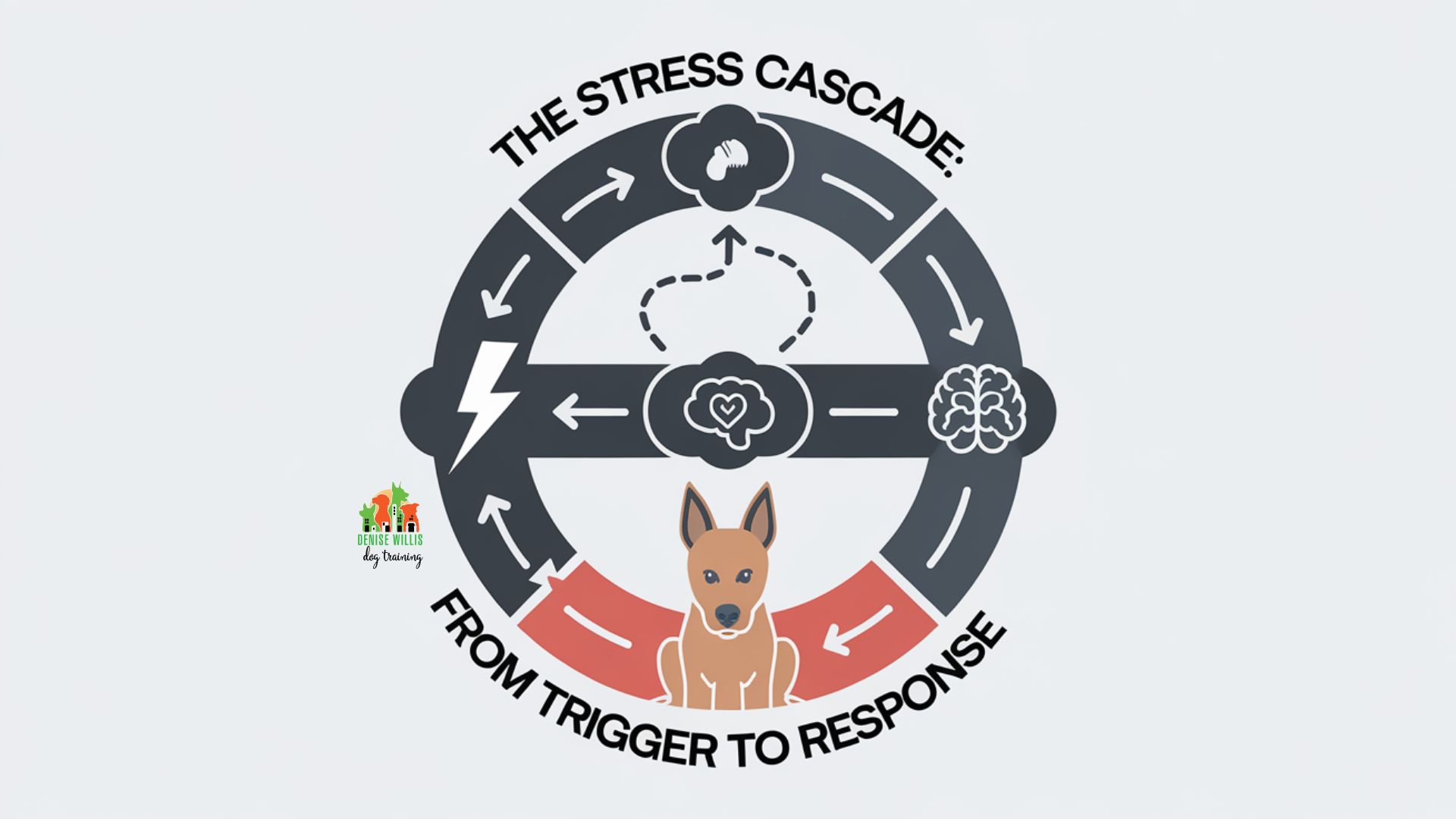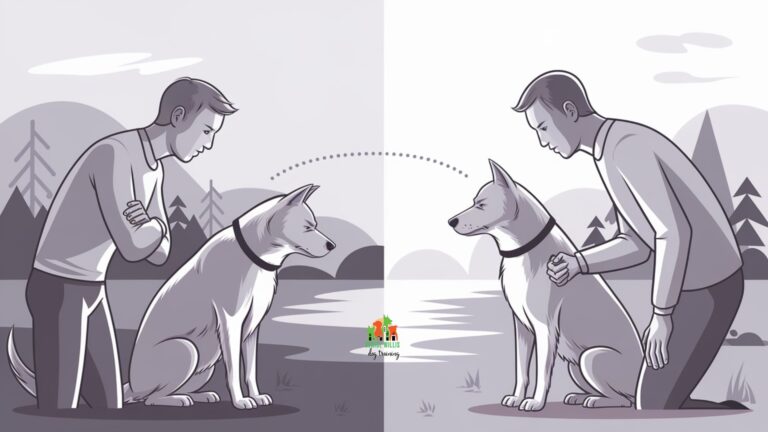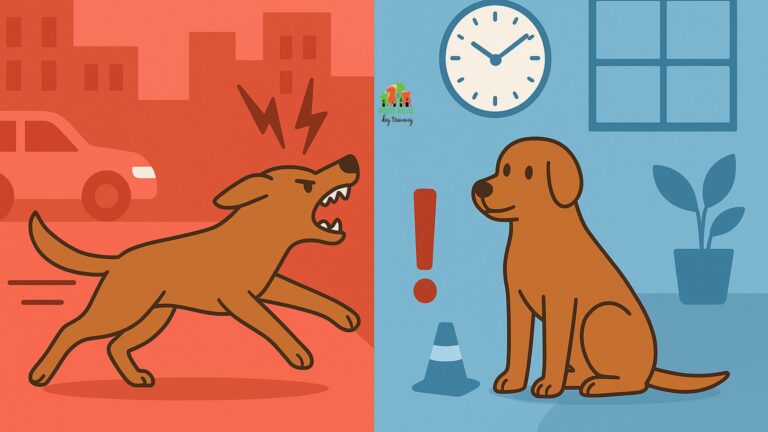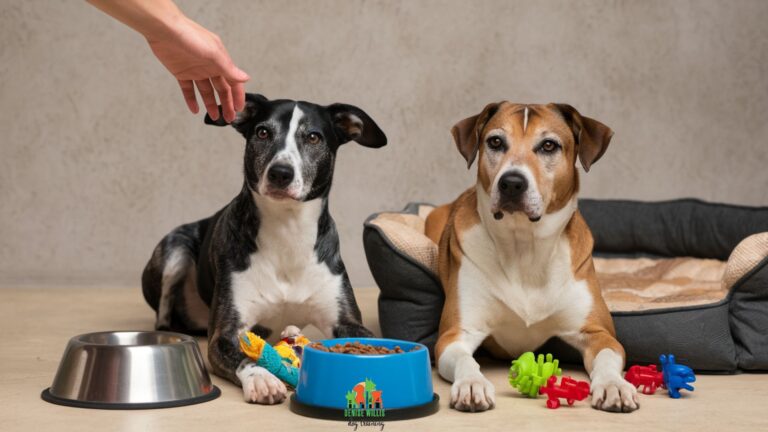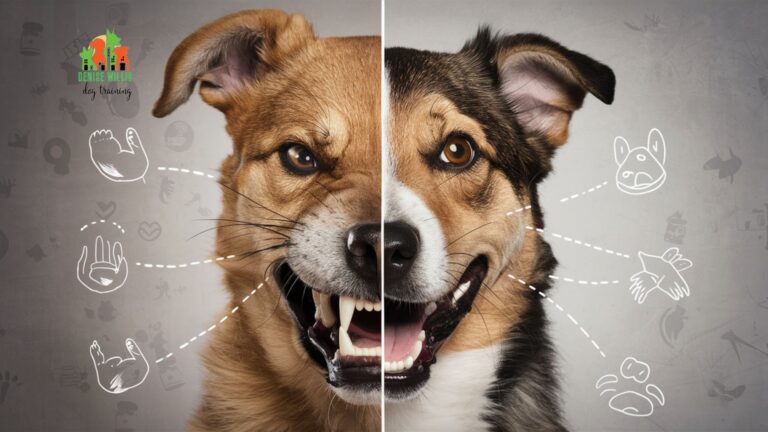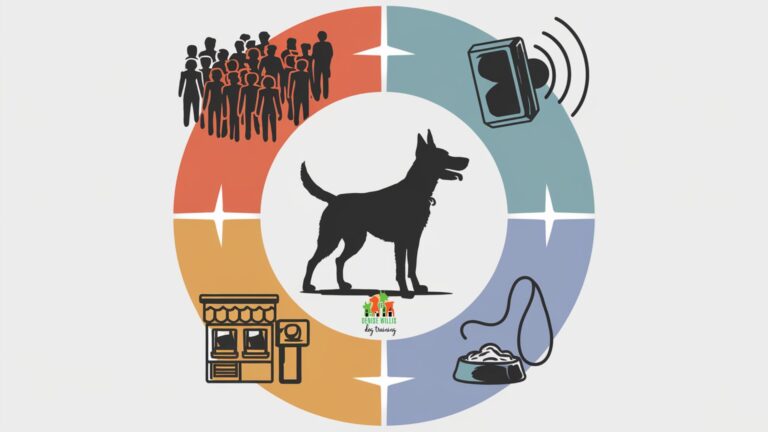When Stress Bites: A Guide to Understanding and Managing Canine Anxiety-Based Aggression
📍 Service Area Notice: DW Dog Training provides in-person training services exclusively in the Greater Baltimore area. While our blog content is designed to help dog owners internationally, our hands-on training services are locally focused. For readers outside our service area, we hope you find value in our articles and welcome you to reach out with questions!
Imagine your normally sweet, tail-wagging companion suddenly freezes, hackles raised, at the sight of a jogger. Your heart races as you wonder what transformed your furry friend into this tense, growling version of themselves. According to research from the American Veterinary Medical Association, this scenario plays out more often than you might think, affecting millions of dog owners worldwide.
Key Takeaways:
- Stress-induced aggression stems from physiological responses, not “bad dog” behavior
- Early recognition of stress signals can prevent aggressive episodes
- Professional intervention often yields the best outcomes
- Environmental management plays a crucial role in reducing stress
- Consistent training and support create lasting changes
The Hidden Language of Stress
Every dog tells a story through their body language, but sometimes we’re not fluent enough to read it. Studies from the Blue Cross for Pets show that dogs typically display up to 30 different stress signals before reaching their breaking point. Think of these signals as your dog’s version of sending a text message.
If we miss too many, they might resort to more dramatic forms of communication.
Reading Your Dog’s Stress Signals
The body language of a stressed dog speaks volumes, even when their voice stays quiet. Research published in Nature reveals that dogs use a sophisticated system of physical cues to communicate their emotional state. These signs include:
- Subtle shifts in ear position and tail carriage
- Changes in breathing patterns and panting
- Alterations in normal behavior patterns
- Physical responses like shaking or yawning
When we understand these signals, we’re better equipped to prevent stress from escalating into aggression. Recent findings from veterinary behaviorists indicate that over 75% of aggressive incidents could have been prevented through early recognition of stress signals.
When Stress Turns to Aggression
Think of your dog’s stress response like a pot of water on the stove. Just as water doesn’t go from cool to boiling instantly, dogs don’t typically jump straight to aggressive behavior. Research from Today’s Veterinary Practice shows that stress-induced aggression usually develops gradually, with multiple warning signs along the way.
A perfect example?
That moment when your neighbor’s well-meaning but overly enthusiastic child runs full-speed at your dog for a hug. Your dog might start with subtle signals – a head turn, a lip lick, a slight body shift – before escalating to more obvious signs of discomfort.
Breaking Down the Dog Stress Puzzle: Key Numbers & Insights
Think your pup’s stress signals are as complex as a Rubik’s cube in the dark?
You’re not alone in this puzzle! I’ve pulled together a visual cheat sheet that breaks down the science of canine stress into bite-sized pieces (pun absolutely intended).
The Four Pillars of Stress Management in Dogs
Early Warning Signs
30+ different stress signals your dog uses before reaching their breaking point. Think of it as their version of texting “we need to talk.”
Stress Hormones
Cortisol can linger in your dog’s system for up to 48 hours. That morning vet visit might affect their evening walk!
Common Triggers
72.5% of dogs show anxiety-related behaviors, with noise sensitivity being the top trigger at 32%. You’re not alone in this!
Professional Help
75% of aggressive incidents could have been prevented through early recognition and intervention. Don’t wait to seek expert guidance!
Just like that one friend who can’t function without their morning coffee, our dogs have their own unique stress responses and triggers. But unlike us, they can’t exactly text us a heads-up when they’re having a rough day. That’s why understanding these patterns is crucial.
It’s like having a decoder ring for your dog’s emotional state!
Want to know what makes this infographic particularly tail-wagging worthy?
Each quadrant represents a key piece of the stress puzzle that we’ve discuss in this article. From those subtle early warning signs (more numerous than your streaming service watchlist) to the fascinating science of stress hormones (spoiler: they’re not fans of quick fixes), we’ve packed it all in there.
Now that we’ve visualized the science behind your pup’s stress signals, let’s dive into some practical solutions that’ll help turn that stress into success.
The Science Behind the Snap
Remember the last time you had a truly awful day at work?
That build-up of stress hormones that made even small annoyances feel huge?
Your dog experiences something similar. Studies published in PetMD reveal fascinating insights about the hormonal dance happening inside our stressed-out pups.
Understanding the Stress Response
When your dog encounters a stressful situation, their body launches into a complex chemical reaction that would make a chemistry teacher proud. Research from the Thriving Canine shows that stress triggers the release of several key hormones:
- Cortisol: The primary stress hormone that can linger in your dog’s system for up to 48 hours
- Vasopressin: Associated with defensive and aggressive responses
- Oxytocin: The “love hormone” that can help counter stress effects
This hormonal cocktail explains why a stressful morning vet visit might leave your dog more reactive to the evening delivery person. It’s not that they’re holding a grudge. Their body is still processing the earlier stress response.
From Fear to Fight
Here’s where things get interesting – and by interesting, I mean scientifically fascinating but potentially problematic for your favorite shoes. According to veterinary behaviorists, stress-induced aggression often follows a predictable pattern:
- Initial Trigger Event: Could be anything from a loud noise to an uncomfortable social interaction
- Physiological Response: Heart rate increases, muscles tense, stress hormones surge
- Fight-or-Flight Activation: Your dog makes split-second decisions about perceived threats
- Behavioral Response: This might range from avoidance to aggressive displays
Real Talk: Stories from the Trenches
Let’s take a moment to hear from real dog parents who’ve walked this path. Reddit’s reactive dogs community has some enlightening stories that might sound familiar if you’re dealing with a stress-reactive pup.
One pet parent shared their journey of managing an anxious German Shepherd: “Training, medication, and a well-fitted muzzle transformed our daily walks from stress-fests into enjoyable outings.” Another success story highlighted how positive reinforcement turned their “anxious trainwreck” into a confident companion.
Key insights from the dog parent community include:
- Recognizing your own stress levels impacts your dog’s behavior
- Early intervention prevents escalation of issues
- Positive reinforcement and consistency are game-changers
- Muzzles can be valuable training tools, not signs of failure
As one experienced owner noted, professional guidance made all the difference: “Having a trainer assess our specific situation gave us the tools we needed to help our dog succeed.”
The Numbers Don’t Lie: A Deep Dive into Dog Anxiety Stats
Ever wondered if your anxiety-prone pup is just being extra, or if they’re part of a larger canine consciousness movement?
Turns out, our four-legged friends are dealing with more stress than a coffee maker on Monday morning. Recent studies have unveiled some eye-opening statistics about our stressed-out sidekicks, and spoiler alert: Your dog isn’t alone in their anxiety journey.
Let’s break down these numbers like a treats puzzle toy – because sometimes, understanding comes from seeing the bigger picture. And trust me, this picture is bigger than that hole your stress-chewer left in your favorite throw pillow.
| Behavior Type | Percentage | Notes | Source |
|---|---|---|---|
| Anxiety-Related Behaviors | 72.5% | Dogs showing at least one anxiety-related behavior | [1][6] |
| Noise Sensitivity | 32% | Most common anxiety-related trait | [1][6] |
| General Fear | 29% | Second most common anxiety trait | [1] |
| Aggression | 14% | Dogs displaying aggressive behaviors | [1][6] |
| Fear of Other Dogs | 17% | Specific fear response to other canines | [6] |
| Fear of Strangers | 15% | Dogs showing fear towards unfamiliar people | [6] |
| Separation Anxiety | 5-6% | Dogs displaying separation-related behaviors | [1][6] |
Well, would you look at those numbers!
They’re about as surprising as finding out your dog actually can hear the treat bag opening from three rooms away. What’s particularly fascinating (or concerning, depending on how you look at it) is that over 70% of our furry friends are dealing with some form of anxiety. That’s more stressed-out pups than there are humans pretending to enjoy kale smoothies!
These statistics aren’t just numbers on a screen. They’re real stories of real dogs (and their slightly frazzled humans) navigating the complex world of canine anxiety. Think of them as your “you’re not alone” support group, minus the awkward introductions and stale coffee.
Now that we’ve crunched the numbers harder than your dog crunches their favorite squeaky toy, let’s talk about what we can actually do about it. Because knowing is half the battle – the other half is preventing your stress-reactive German Shepherd from declaring war on the Amazon delivery person.
Creating Calm in Chaos
Let’s be honest.
We can’t bubble-wrap our dogs or protect them from every stressful situation. But we can create an environment that helps them cope better. Research from Hill’s Pet suggests that environmental management plays a crucial role in reducing stress-induced aggression.
Environmental Solutions
Think of your home as your dog’s emotional safety net. Just as you might need a quiet room after a challenging day, your dog needs spaces where they can decompress. Consider these science-backed strategies:
- Create designated “chill zones” where your dog can retreat
- Use calming aids like classical music or pheromone diffusers
- Establish predictable routines that help your dog feel secure
- Manage exposure to known stressors through thoughtful planning
Training Techniques That Work
Training a stressed dog isn’t about domination or forcing them to “get over it.” Studies from the Blue Cross show that positive reinforcement techniques yield the best results. Think of it like teaching someone to swim. Throwing them in the deep end rarely ends well.
Successful stress management often involves:
- Counter-conditioning to change emotional responses
- Desensitization to reduce reaction to triggers
- Positive reinforcement to build confidence
- Management strategies to prevent overwhelming situations
Professional Support: When and Why
Remember that time you tried to fix your own plumbing and ended up with an impromptu indoor swimming pool?
Sometimes DIY isn’t the best approach. The same goes for managing serious stress-induced aggression. Our data shows that early professional intervention leads to significantly better outcomes – and fewer soggy carpets, metaphorically speaking.
Think of professional trainers as your dog’s stress management coaches. Just as you might hire a personal trainer to help you achieve your fitness goals (and avoid throwing out your back attempting advanced yoga poses), a qualified dog trainer can guide you through the complex world of canine behavior modification.
Finding the Right Help
Not all trainers are created equal.
Shocking, I know.
According to the International Association of Canine Professionals, it’s crucial to find someone who understands the nuances of stress-induced aggression. This isn’t about teaching your dog to high-five (though that’s admittedly adorable). We’re talking about rewiring emotional responses and building confidence.
Look for professionals who:
- Use science-based training methods
- Have experience with anxiety and aggression cases
- Offer comprehensive behavior modification plans
- Include family training and support
Building a Support Team
Creating a support network for your stressed-out pup is like assembling the Avengers of the dog world. Research from veterinary behaviorists suggests that the most successful outcomes involve:
- A qualified veterinarian to rule out medical issues
- A professional trainer for behavior modification
- A supportive family committed to consistency
- Understanding friends who won’t label your dog as “bad”
Living with a Reactive Dog
Let’s get real for a moment.
Sharing your life with a stress-reactive dog can feel like navigating a minefield while juggling flaming torches. In our years of working with reactive dogs at DW Dog Training, we’ve seen it all – from the German Shepherd who thought mail carriers were ninja assassins to the Chihuahua convinced that passing clouds were plotting against him.
But here’s the silver lining: studies from the American Working Dog Federation show that with proper management and training, most reactive dogs can learn to navigate their world more confidently.
Think of it like teaching someone with a fear of public speaking. You wouldn’t start them off at a TED Talk – you’d begin with smaller, manageable challenges. The same principle applies to your stress-reactive pup.
Daily Management Strategies
Managing your dog’s stress is like being their personal event planner – minus the clipboard and sensible shoes (though those might help). After working with hundreds of stressed dogs, we’ve developed a foolproof strategy that works wonders:
- Scout routes for walks that avoid known triggers (we call this the “ninja walk technique”)
- Create a daily routine that minimizes stress (predictability is your friend)
- Plan ahead for potentially challenging situations (yes, this means becoming a part-time psychic)
- Keep a “stress diary” to track triggers and progress (because even dogs need their stories told)
Research from Hill’s Pet backs up what we’ve seen in practice: consistency and routine can reduce stress-related behaviors by up to 70%.
Think about it.
When was the last time you felt stressed while following a familiar, comfortable routine? (Holiday dinner with the in-laws doesn’t count.)
The Recovery Process
One thing we’ve learned from countless training sessions is that progress isn’t linear. Some days your dog might handle the neighbor’s cat like a zen master; other days, they might lose their cool over a rogue leaf. According to behavioral experts, this is completely normal. Recovery looks more like a squiggly line than a straight path – kind of like your signature after four cups of coffee.
Success stories we’ve witnessed include:
- The Great Dane who went from fearing small dogs to becoming a gentle playground mentor
- A reactive Border Collie who learned that the vacuum cleaner wasn’t actually a sheep-eating monster
- The rescue Pit Bull who transformed from stress-reactive to therapy dog superstar
The Science of Success
Here’s where the magic happens – and by magic, we mean scientifically-proven behavioral modification techniques. Research from veterinary behaviorists shows that successful stress management involves rewiring neural pathways through consistent positive experiences. Think of it as updating your dog’s internal software – except you don’t have to sit through those annoying “installation complete” messages.
Key components of success include:
- Systematic desensitization (fancy talk for “baby steps”)
- Counter-conditioning (making scary things awesome)
- Stress threshold management (keeping your dog in the “thinking zone”)
- Reward-based training (because who doesn’t love positive reinforcement?)
Product Recommendations
Looking to help your stressed-out pup find their inner zen master?
We’ve curated a collection of sanity-saving products that might just turn your worried warrior into a calm companion. Think of it as your dog’s personal anti-stress toolkit – minus the meditation apps and yoga mat (though we’d pay good money to see a dog attempt Downward Dog).
- ThunderShirt Sport Dog Anxiety Jacket: Like a warm hug from a thousand tiny angels, this anxiety wrap helps your pup feel secure when the world gets too “worldy.” The snug fit applies gentle, constant pressure – think of it as Spanx for your dog’s emotions, but way more comfortable. Warning: May cause excessive relaxation and spontaneous napping in previously caffeinated canines.
- RUFFWEAR Front Range Dog Harness: Think of it as your dog’s emotional support armor. This ergonomic harness gives you better control during stress-inducing situations while keeping your pup comfortable and secure. It’s like giving your dog a confidence-boosting superhero suit, complete with reflective trim for those early morning “please don’t let us see any squirrels” walks. Warning: May cause your dog to strut around like they’re on a fashion runway in Paris.
- Calming Zen Chews by Zesty Paws: These treats are like yoga class in a bottle for your furry friend. Packed with natural calming ingredients, they help take the edge off without turning your guard dog into a sleepy sloth. Warning: Your dog may start showing up at the treat cabinet doing deep breathing exercises.
- PetSafe Busy Buddy Tug-A-Jug: A puzzle toy that keeps anxious minds occupied and away from stress-chewing your favorite shoes. It’s like Netflix for dogs – endlessly entertaining and slightly addictive. Warning: May create a dog smarter than your average teenager.
- Smart Pet Love Snuggle Puppy: This plush toy with a heartbeat helps anxious dogs feel less alone. Think of it as their emotional support stuffed animal. Perfect for dogs who need a cuddle buddy but find your snoring offensive. Warning: Don’t be jealous when your dog starts preferring its company over yours during movie night.
Further Reading
Ready to dive deeper into the world of canine stress management? We’ve gathered some brain-tickling articles that’ll turn you into a dog psychology pro. Just don’t start charging your pup for therapy sessions.
- 10 Warning Signs Your Dog Might Bite and How to Prevent It: Because sometimes “kiss kiss” can turn into “snap snap.” Learn to read your dog’s subtle hints before they resort to more dramatic forms of communication. Spoiler alert: The “side-eye” means more than you think.
- Decoding Your Dog: 15 Body Language Signals You Need to Know: Become fluent in tail wags, ear positions, and those mysterious head tilts. It’s like learning a new language, but with more belly rubs and fewer conjugation rules.
- How to Manage Your Dog’s Territorial Aggression: For when your dog thinks they’re the bouncer at Club Backyard. Learn how to help them chill out about their imaginary real estate empire.
- 5 Proven Strategies to Stop Your Dog’s Aggression Towards Other Dogs: Transform your canine critic into a social butterfly. Warning: May result in too many doggy playdate invitations.
- The Shy Dog’s Guide to Conquering Fear: Help your wallflower bloom into a confident canine. Because everyone deserves to feel like the belle of the dog park.
Time to put on your reading glasses and get that brain working!
These articles are packed with more wisdom than a fortune cookie factory – and they’re a lot more practical for dog training. Your pup may not be impressed by your newfound knowledge, but they’ll definitely appreciate the results!
Test Your Dog Stress Detective Skills!
Think you’ve got what it takes to decode your dog’s secret stress signals?
Time to put your newfound knowledge to the test! I’ve crafted a quick quiz that’s more fun than a tennis ball in a pool of squeaky toys. Don’t worry – unlike your dog’s judgment when you pretend to throw the ball, this quiz is totally judgment-free!
Test Your Dog Stress Detective Skills!
Whether you aced it like a pro or need to fetch a bit more knowledge, remember that understanding your dog's stress signals is an ongoing journey. Think of it as learning a new language - except instead of conjugating verbs, you're decoding tail positions and ear angles!
Frequently Asked Questions About Stress-Induced Aggression
Q: Can my stressed-out dog ever become a social butterfly?
A: While your pup might not host dinner parties anytime soon, behavioral studies show that most dogs can learn to navigate social situations with confidence. Think of it like teaching your tech-challenged uncle to use a smartphone - progress happens, just maybe not at lightning speed.
Q: Is my dog's stress my fault?
A: About as much as it's your fault that pineapple on pizza exists - which is to say, not at all. Research shows that stress responses develop from a complex mix of genetics, environment, and experiences. What matters isn't how you got here, but what you do next.
Q: Do I need to rehome my stressed-reactive dog?
A: Before you start browsing pet adoption websites, take a breath. Our experience shows that most stress-reactive dogs can learn to manage their responses with proper training and support. Remember, even Bruce Banner learned to control his inner Hulk.
Q: Will my dog need medication forever?
A: Not necessarily. While some dogs benefit from long-term medication support, many others use it as a temporary aid during behavior modification. Think of it like training wheels on a bike - helpful for balance at first, but not always needed forever.
Moving Forward Together
Let's be real.
Managing a stress-reactive dog isn't always a walk in the park (sometimes it's more like an obstacle course through a minefield). But here's what we've learned from years of working with anxious pups: progress is possible, and often incredible.
Your Next Steps
- Start a stress diary (yes, like a middle school journal, but with fewer crush confessions)
- Create a safe space for your dog (their version of your "don't talk to me before coffee" zone)
- Consider professional evaluation (that's where we come in - minus the clipboard and judgment)
- Build your support network (because everyone needs a cheerleading squad)
Share Your Journey
Remember that German Shepherd we mentioned earlier who thought mail carriers were ninja assassins? He now accepts packages with all the enthusiasm of a DMV employee on a Monday morning - and that's a huge win! Every dog's journey is unique, but they all share one thing: the potential for positive change.
At DW Dog Training, we've seen countless success stories unfold, each as unique as the dogs and humans involved. Our experience shows that with patience, understanding, and the right support, your stress-reactive dog can learn to navigate their world with greater confidence and less drama.
Ready to help your dog stress less and wag more?
We're here to guide you through every step of the journey - no judgment, just support and maybe a few dad jokes along the way. Because at the end of the day, every dog deserves to feel safe and confident in their world, even if they never quite make peace with the vacuum cleaner.

